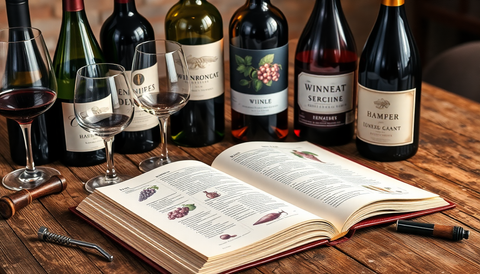As we delve into the captivating world of wine, one of the most fundamental and intriguing aspects to explore is the role of acidity. Often overlooked by casual drinkers, acidity is a crucial component that can make or break the overall experience of a wine. In this comprehensive blog post, we'll embark on a journey to unravel the mysteries of wine acidity and its delicate balance, equipping you with the knowledge to appreciate and savor your favorite wines like never before.
The Importance of Acidity in Wine
Acidity is the backbone of wine, providing the necessary structure and liveliness that distinguishes a well-crafted vintage from a flat, one-dimensional one. It is the interplay between acidity, sweetness, tannins, and alcohol that creates the harmonious balance that wine enthusiasts seek. Without the right level of acidity, a wine can taste flabby, dull, or even unpleasant, failing to captivate the palate and leaving the drinker unsatisfied.
Understanding the Science of Acidity
At its core, acidity in wine is determined by the presence of various organic acids, primarily tartaric, malic, and citric acids. These acids are naturally present in grapes and play a crucial role in the winemaking process. Tartaric acid, for instance, is the predominant acid found in grapes and contributes to the wine's overall structure and longevity. Malic acid, on the other hand, imparts a crisper, tart flavor, while citric acid adds a refreshing, zesty note.
The balance of these acids, along with the wine's alcohol content, sugar levels, and tannins, creates the unique flavor profile that distinguishes one wine from another. A well-balanced wine will have a harmonious interplay of these elements, where no single component overpowers the others, resulting in a seamless and enjoyable drinking experience.
Exploring the Acidity Spectrum
Wines can exhibit a wide range of acidity levels, from the bright, high-acid whites to the softer, lower-acid reds. Understanding the acidity spectrum and how it affects the overall character of a wine is crucial for developing your palate and appreciating the nuances of different wine styles.
High-Acid Wines
High-acid wines, such as Sauvignon Blanc, Riesling, and Pinot Grigio, are characterized by a vibrant, tart, and refreshing mouthfeel. These wines are often described as having a "zing" or "bite" to them, which can be particularly appealing on a hot summer day or paired with rich, fatty foods. The high acidity in these wines helps to balance out the sweetness, creating a harmonious and invigorating drinking experience.
Medium-Acid Wines
Many popular red and white wines, such as Chardonnay, Merlot, and Cabernet Sauvignon, fall into the medium-acid category. These wines strike a delicate balance between the bright, zesty notes of high-acid wines and the softer, more rounded profiles of low-acid wines. The moderate acidity in these wines provides structure and complexity, allowing the other flavor components, such as fruit, oak, and tannins, to shine.
Low-Acid Wines
On the opposite end of the spectrum, low-acid wines, like Malbec, Syrah, and some Chardonnays, exhibit a more mellow, velvety mouthfeel. These wines tend to have a rounder, more full-bodied character, with the acidity playing a supporting role rather than taking center stage. While the lower acidity can make these wines feel softer and more approachable, it's important to note that the balance between acidity, alcohol, and other flavor components is still crucial for creating a harmonious and enjoyable drinking experience.
The Role of Acidity in Food Pairing
Acidity is not only crucial for the wine's internal balance but also plays a vital role in the art of food pairing. The interplay between the wine's acidity and the flavors and textures of the food can either enhance or detract from the overall dining experience.
Pairing High-Acid Wines
High-acid wines, such as Sauvignon Blanc and Riesling, are often paired with rich, fatty, or creamy dishes to help cut through the heaviness and cleanse the palate. The bright, zesty acidity in these wines can also complement and balance out spicy or acidic foods, creating a harmonious and refreshing pairing.
Pairing Medium-Acid Wines
Medium-acid wines, like Chardonnay and Merlot, are versatile and can be paired with a wide range of dishes. Their balanced acidity allows them to complement both lighter, more delicate fare as well as heartier, more robust meals. The moderate acidity in these wines can also help to cut through the richness of certain dishes, making the pairing more harmonious and enjoyable.
Pairing Low-Acid Wines
Low-acid wines, such as Malbec and Syrah, are often paired with grilled, roasted, or braised meats, as the softer, more velvety mouthfeel of these wines can complement the bold flavors and textures of the food. The lower acidity in these wines also allows them to pair well with dishes that have a higher fat content, as the wine's acidity is not as pronounced to cut through the richness.
Factors Influencing Acidity in Wine
Acidity in wine is not a static characteristic; it can be influenced by a variety of factors, both in the vineyard and during the winemaking process. Understanding these factors can help you better appreciate the nuances of different wine styles and how they can evolve over time.
Grape Variety
The grape variety used to produce the wine is a significant factor in determining its acidity levels. Some grape varieties, such as Riesling and Sauvignon Blanc, naturally have higher acidity, while others, like Merlot and Cabernet Sauvignon, tend to have lower acidity.
Climate and Terroir
The climate and terroir (the unique combination of soil, climate, and geography) of the wine's growing region can also impact the acidity levels. Cooler climates, for instance, tend to produce grapes with higher acidity, while warmer regions may result in grapes with lower acidity.
Winemaking Techniques
The winemaking process itself can also influence the wine's acidity. Techniques like malolactic fermentation, which converts the harsher malic acid into the softer lactic acid, can reduce the overall acidity of the wine. Conversely, certain winemaking practices, such as the use of stainless steel tanks or the addition of tartaric acid, can help to preserve or even increase the wine's acidity.
Aging and Maturation
As a wine ages, its acidity can evolve and change over time. During the aging process, certain acids may break down or transform, altering the wine's overall acidity profile. This is particularly evident in older, more mature wines, where the acidity may become more integrated and less pronounced, contributing to the wine's complexity and balance.
Mastering the Art of Acidity Balance
Achieving the perfect balance of acidity in a wine is a delicate and nuanced art form that requires a deep understanding of the various factors at play. Winemakers must carefully consider the grape variety, growing conditions, and winemaking techniques to craft a wine that showcases the ideal level of acidity, complementing the other flavor components and creating a harmonious and enjoyable drinking experience.
Identifying Acidity in Wine Tasting
Developing the ability to identify and assess the acidity in a wine is an essential skill for any wine enthusiast. During a wine tasting, you can observe the wine's acidity by noting the mouthfeel, the way the wine interacts with your salivary glands, and the overall impression of freshness or tartness on the palate.
Adjusting Acidity in Winemaking
In the winemaking process, adjusting the acidity levels is a common practice to ensure the wine's balance and stability. Winemakers may add or remove certain acids, such as tartaric or malic acid, to fine-tune the wine's acidity profile and achieve the desired flavor profile.
Appreciating the Role of Acidity in Wine Enjoyment
Ultimately, the role of acidity in wine is not just a technical consideration; it is a crucial component that contributes to the overall enjoyment and appreciation of the wine. By understanding the importance of acidity and its impact on a wine's flavor, structure, and food pairing potential, you can unlock a deeper level of understanding and appreciation for the art of winemaking and the pleasure of wine consumption.
As you continue your journey through the world of wine, remember that acidity is not just a number or a scientific measurement, but a dynamic and essential element that can make the difference between a forgettable wine and a truly memorable one. Embrace the exploration of acidity, and let it guide you on a captivating adventure through the diverse and fascinating world of wine.




Comments (0)
There are no comments for this article. Be the first one to leave a message!